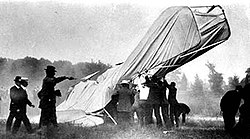This article needs additional citations for verification .(July 2013) |
This is a list of accidents and incidents involving military aircraft grouped by the year in which the accident or incident occurred. Not all of the aircraft were in operation at the time. For more exhaustive lists, see the Bureau of Aircraft Accidents Archives [1] or the Aviation Safety Network [2] or the Scramble on-line magazine accident database. [3] Combat losses are not included except for a very few cases denoted by singular circumstances.
Contents
- Aircraft terminology
- 1861
- 1895
- 1907
- 1908
- 1909
- 1910
- 1911
- 1912
- 1913
- 1914
- 1915
- 1916
- 1917
- 1918
- 1919
- 1920
- 1921
- 1922
- 1923
- 1924
- See also
- References
- External links













